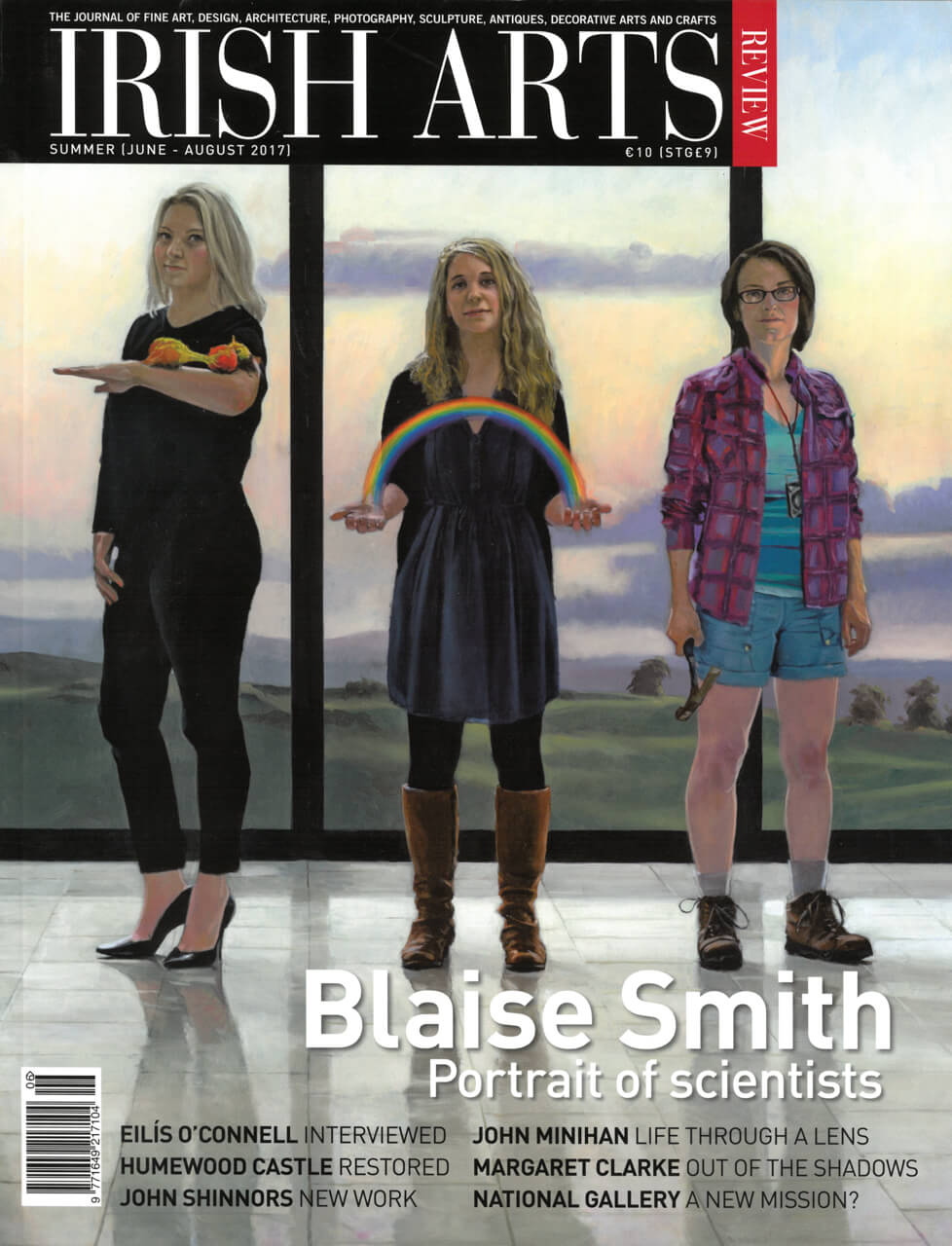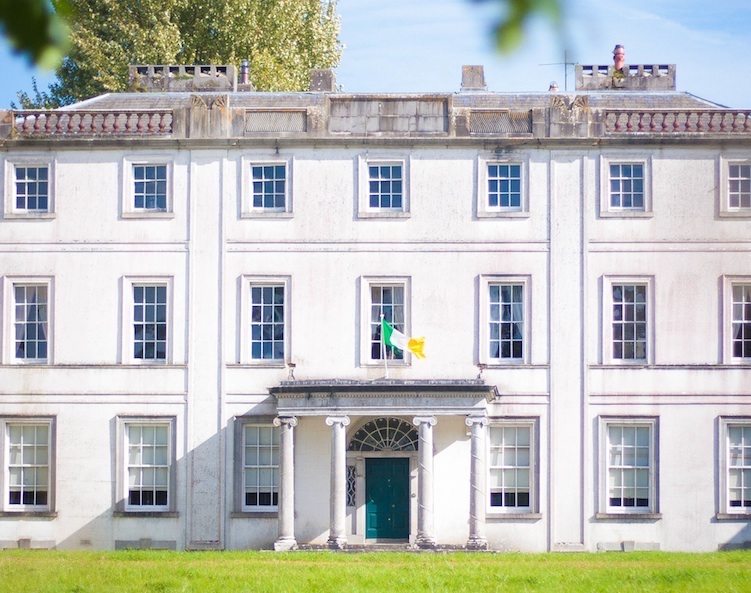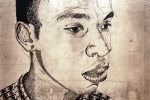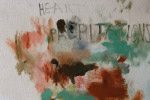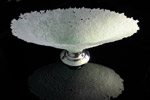
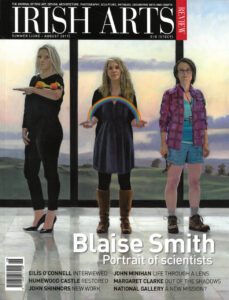
[slider_pro id=”269″]
From the Summer 2017 edition
The allure of art glass and proximity to the sea combine in the career of Cork-based sculptor-designer Eoin Turner, writes Mark Ewart
The splendour and beauty of the sea has had an enduring impact upon the life and work of sculptor and glass designer Eoin Turner. In particular, his years working on a fishing trawler in the dangerous and unpredictable waters off the South West Coast, left an irrevocable mark upon him. In sharp contrast however – and indeed within 24 hours of leaving West Cork – Turner found himself in the glamorous Mediterranean resort of Antibes, on the C√¥te d’Azur . He was to spend two years working in the South of France, doing everything from painting hulls in dry-dock at Marseille, to captaining motor yachts for tycoons and oligarchs (including patrons of prestigious galleries and fashion design houses).
Even though Turner is an accomplished seaman (having earned his Skipper’s ticket in 1996), he never completely lost touch with art and design, using onshore lay-ups to sketch and paint. His time in France introduced him to the worldwide potential for art and design within the marine architecture marketplace. So with a young family to support – he decided in 2001 to establish a small workshop in Cork City. Today from his much larger 5,000 square foot space in Glanmire Co Cork, he has, in a sense, come full circle. This is because his work once again brings him back into contact with the rich and famous – for instance businessman and Formula 1 enthusiast Eddie Jordan, has become a devoted client.
There is something compelling about this backstory and how the physical challenges and allure of the sea, underscored Turner’s artistic identity.
There is something compelling about this backstory and how the physical challenges and allure of the sea, underscored Turner’s artistic identity. ‘It was my history’. 1 he confirms, ‘I was at sea for ten years and it was very important to me. I grew up with an aspiration to go to sea and to work on boats.’ A comparison with his 19th-century namesake, JMW Turner comes to mind, as both had a fascination with the sea and a desire to channel this into the elements of their respective art forms.
When Turner started at the Crawford College of Art and Design in Cork City in 1984, he was studying painting and had not yet considered glass as a medium. But an interaction with the sculptor Maud Cotter – who was at that time course director for stained glass at CCAD – changed all that. ‘We were doing a project in relation to fabrics and attire’ he says, and ‘It was Maud who came out with the nugget of knowledge that you could bend glass using heat in a kiln’. Then using sections of drawings based on an old pair of jeans as a starting point, he recalls how he, ‘bent some small pieces of coloured glass and made them into a 3D pattern. That was literally the start of the glass, that one piece’. Glass is a temperamental medium to work with. Simultaneously strong and brittle, it is mercurial when heated and will flow into an amorphous form if left unchecked by a mould. Water behaves in similar ways; it also flows and will set hard when frozen, it conforms to a container or becomes liberated when a gas. Both are transparent and are conduits for colour and pattern, capturing and reflecting ambient light. So are the artistic and biographical links between glass and water a conscious statement of intent? ‘I hadn’t considered it greatly before’ he admits, ‘but over the last two decades you can see glass used more and more in architecture and naval architecture. You could certainly connect glass to the fluidity of water. If you ever dive incorrectly from a diving board you discover very quickly that water gets harder the further away you get from it’.
Many artists value the exploration of visual and tactile stimuli as opposed to cerebral subject matter. Educationalist Olivia Gude defines this as ‘attentive living’2 where primary sensory inspiration, guides creativity. This is pertinent; as of course it is light, rather than water, which has true synchronicity with glass. For Turner though he does not necessarily see light in terms of refraction, ‘For me, it’s more often reflected light because I use a lot of metals in my work‚Ķ gold leaf, silver leaf, aluminium leaf. So it’s the bouncing of light back out of the glass that is critical. That’s where the pieces become back-to-front paintings for me’.
Turner’s marine commissions have made his name and articles on his work can be found in such publications as Yachting, Boat and Top Marques Monaco. This publicity presents Turner as a much sought-after brand name, sitting alongside Franck Muller and Fabergé watches or Aston Martin and DeLavilla supercars – which is certainly not bad company for the Corkman to keep. Since money follows talent and talent is drawn to money, it is not surprising to learn from Turner that the luxury goods marketplace bankrolls innovation in naval architectural technology. On the back of this, Turner has found a niche that allows him to experiment more and more with the potential of glass as a business as well as an artistic outlet. The brand was established through synergy with his wife, Lorraine Mullins, who is a painter. ‘She is the backbone and runs everything from day to day dealing with clients, to purchases,’ he explains. ‘Lorraine has seen the business through the economic cycles of the last two decades. The last couple of years our three children are getting older, Lorraine has returned to her own work painting in the studio. It is interesting to see Lorraine’s painterly aesthetic coming into my own work.’
The technical specifications for marine architecture bring a very different focus compared to Turner’s land-based commissions. ‘The hoops we have to jump through are extraordinary. That’s the whole other side of this business that we have become adept at. I love the engineering side of it and we have to consider impact and vibration and fire ratings as well as IMO [International Marine Organisation] certification and Lloyds certification’. But the part which appeals most to him is when he is able to satisfy the ‘layers of management’ that surround each contract and simply sit opposite a client ‘scattering out your drawings and with a 2B pencil in your hand, scratching out things and pushing ideas around the paper’.
The technical specifications for marine architecture bring a very different focus compared to turner’s land-based commissions
This face-to-face interaction will naturally occur with greater frequency when carrying out local commissions. Installations at Cork Crematorium, the chapel at Manresa House for the Jesuit order in Dollymount, Dublin, or the ‘monumental scale’ of the recent installation at the impressive re-imagining of Nano Nagle’s Tomb and gardens in Cork City, are examples (Fig 2). Here, Turner was able to propose materials and ideas through direct conversations with the clients. Similarly so, the recent commission for Christ Church Cathedral in Dublin. In this piece – which is situated behind the main altar – there is a Minimalist simplicity, as the elegant Gothic arch shape, sumptuous crimson glass and gold leaf-adorned structure, show. It nevertheless evokes a tranquillity and stillness that is entirely in keeping with the sanctity of the space. Perhaps working on such commissions allows a discreet nod toward spirituality to influence Turner’s marine commissions as well? Certainly during his time as a fisherman, the sway of the vast oceans and infinite sky above, surely prompted his psyche to ponder deeper questions surrounding life, death and eternity. An iconoclast might go even further and mischievously imply there is, historically, little to differentiate between the church and capitalism, due to their respective appropriation of wealth and property. But a softer view is required and indeed, Turner is more interested in the metaphorical similarities, ‘One of the leading yacht designers in the World, Tim Heywood, equated superyachts to ‘modern cathedrals’ – and yes, they are the cathedrals of our time’. And while Turner accedes this is a captivating analogy, he reflects ‘we are unlikely to be visiting them in 500 years time’. Perhaps this is the nub of why he secures commissions from wealthy yacht owners, whom it might be argued; seek to pay homage to their own materialism. Whereas for contemporary churches – stone, wood and glass are used to exalt Divinity in communion. Turner’s glass and metal sculptures of yachts are at the very least a celebration of the purity of architectural form. But on the other hand, to the person-in-the-street, they might be seen perhaps as effigies to hedonism – adorned sometimes with titanium, black pearls or even diamonds. A passing comparison can be made to Damien Hirst’s $100 million diamond encrusted skull, For the Love of God and the ethical and moral furore it provoked. Jeremy Biles considers this artwork a ‘complex ambivalent aesthetic phenomenon’. but is unsure whether it is ‘an icon of grotesque excess or an ironic critique of the same’. 3 Perhaps some of Turner’s more extravagant commissions would sneak in the backdoor of such a debate?
We end with a less provocative deliberation on the role of art education in Irish schools and colleges. Turner recalls being approached by concerned parents seeking recommendations for a career in art or design for their children. ‘Apart from being poverty-stricken [he laughs] the skill to be able to adapt is a great thing to have through life. I used to champion a fine art education on that basis alone’. Going further back still he recalls his school days in Cork and how in the late 1970s early 1980s, art and design was not highly valued on the curriculum. ‘Ashton School was a phenomenally notable exception’ Turner says ‘and being taught by the now almost iconic Liam Nott [who also taught Alex Pentek], allowed us to believe that we could be something other than an engineer or an accountant – and while the world needs all of these people – I think Ashton allowed us to believe that the world could do with a few artists as well’. Art educators across the country would surely hope this message could be heard today by those responsible for funding arts education in Ireland.
Mark Ewart lectures at CIT Crawford College of Art and Design. He is also an art teacher, writer and artist based in Cork City.
1 Conversations with Eoin Turner, 16 March and 10 April, 2017 and all subsequent quotes from the artist.
2 Olivia Gude, ‘Principles of Possibility: Considerations for a 21st-Century Art & Culture Curriculum’, Art Education 60 no 1, 2007.
3 Jeremy Biles, ‘For the Love of God: Excess, Ambivalence and Damien Hirst’s Diamond Skull’, The Uses of Excess in Visual and Material Culture, 1600-2010 (Ed). Julia Skelly, Ashgate, Surrey England, 2014 p. 225.
